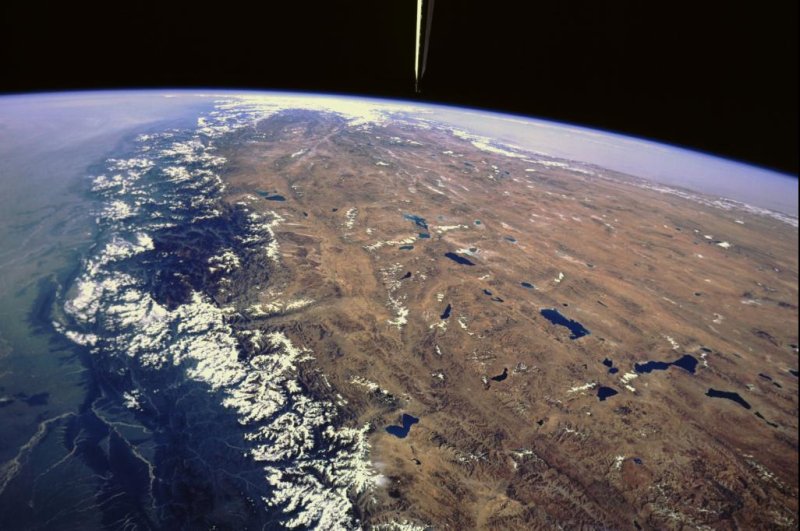The Tibetan Plateau as pictured from Space Shuttle Challenger in 1984. Photo by NASA
June 7 (UPI) -- According to a newly conducted seismic CT scan, the southern half of the Tibetan Plateau, the "Roof of the World," was created by a sudden uplift.
The plateau's dramatic rise occurred during the first 10 million years after the tectonic collision between Asia and India began some 45 million years ago.
Researchers used an analysis method called "full waveform inversion" to integrate a large seismic dataset, which allowed scientists to differentiate between the upper-mantle lithosphere in Southern Tiber and the bedrock of the surrounding region.
"Our seismic image suggests that the Tibetan lithosphere thickened and formed a denser root that broke away and sank deeper into the mantle," Min Chen, a researcher at Rice University, said in a news release. "We conclude that most of the uplift across Southern Tibet likely occurred when this lithospheric root broke away."
Scientists know the Tibetan Plateau was born of the continental collision between India and Eurasia, but the specific geophysical forces that triggered the plateau's rise aren't well understood.
The latest research, published in the journal Nature Communications, could offer new insights into the plateau's formation process.
"The leading theory holds that the plateau rose continuously once the India-Eurasia continental collision began, and that the plateau is maintained by the northward motion of the Indian plate, which forces the plateau to shorten horizontally and move upward simultaneously," said Fenglin Niu, a professor of Earth science at Rice. "Our findings support a different scenario, a more rapid and pulsed uplift of Southern Tibet."
In the wake of the India-Eurasia continental collision, neither of the plates proved conducive to subduction. Both plates were rigid and buoyant. They came together to form a thick slab of lithosphere. But one plate, on the Tibetan side, was more deformable than the other, and eventually the denser portion of lithosphere sank.
"The T-shaped piece of foundered lithosphere sank deeper into the mantle and also induced hot upwelling of the asthenosphere, which leads to surface magmatism in Southern Tibet," Chen said.
Researchers suggest the rapid uplift corresponds with patterns of magmatism that can be observed in Tibetan rock strata dated to 30 million years ago.
"The spatial correlation between our tomographic model and Oligocene magmatism suggests that the Southern Tibetan uplift happened in a relatively short geological span that could have been as short as 5 million years," Chen said.















